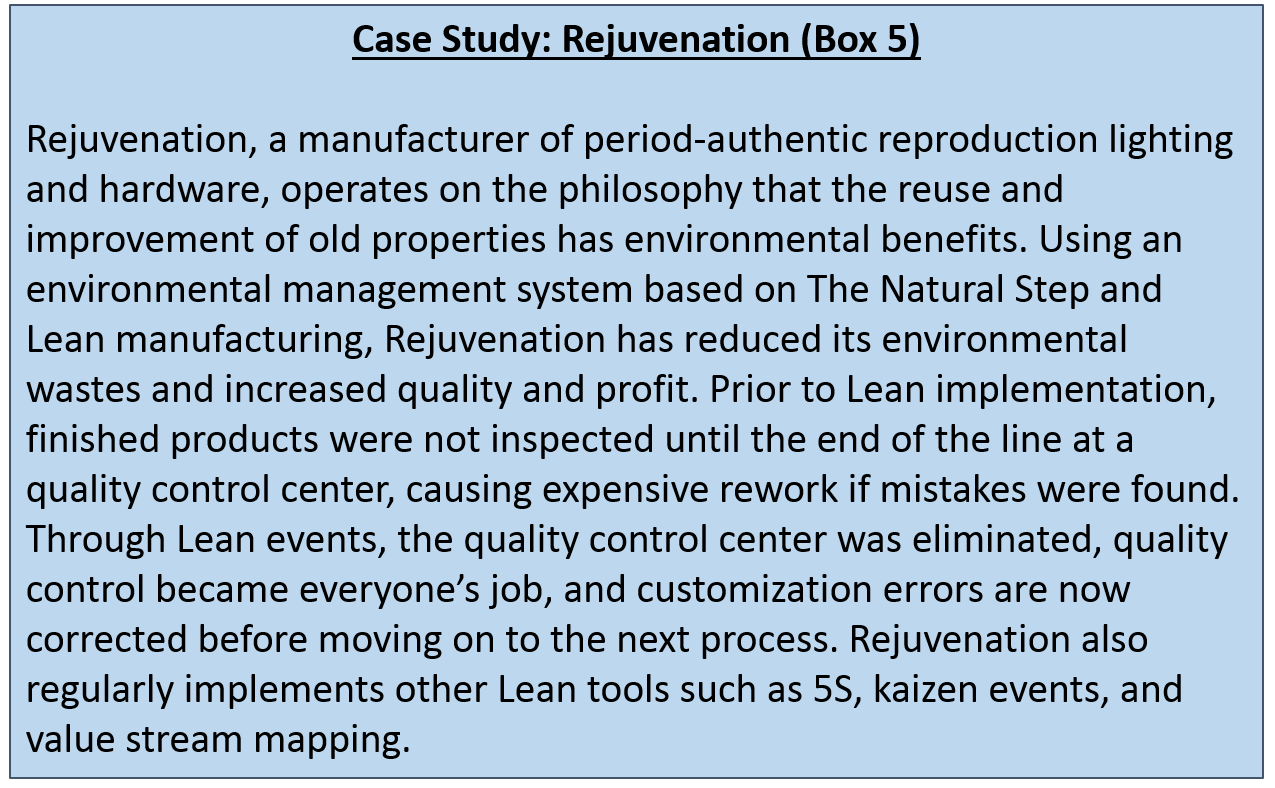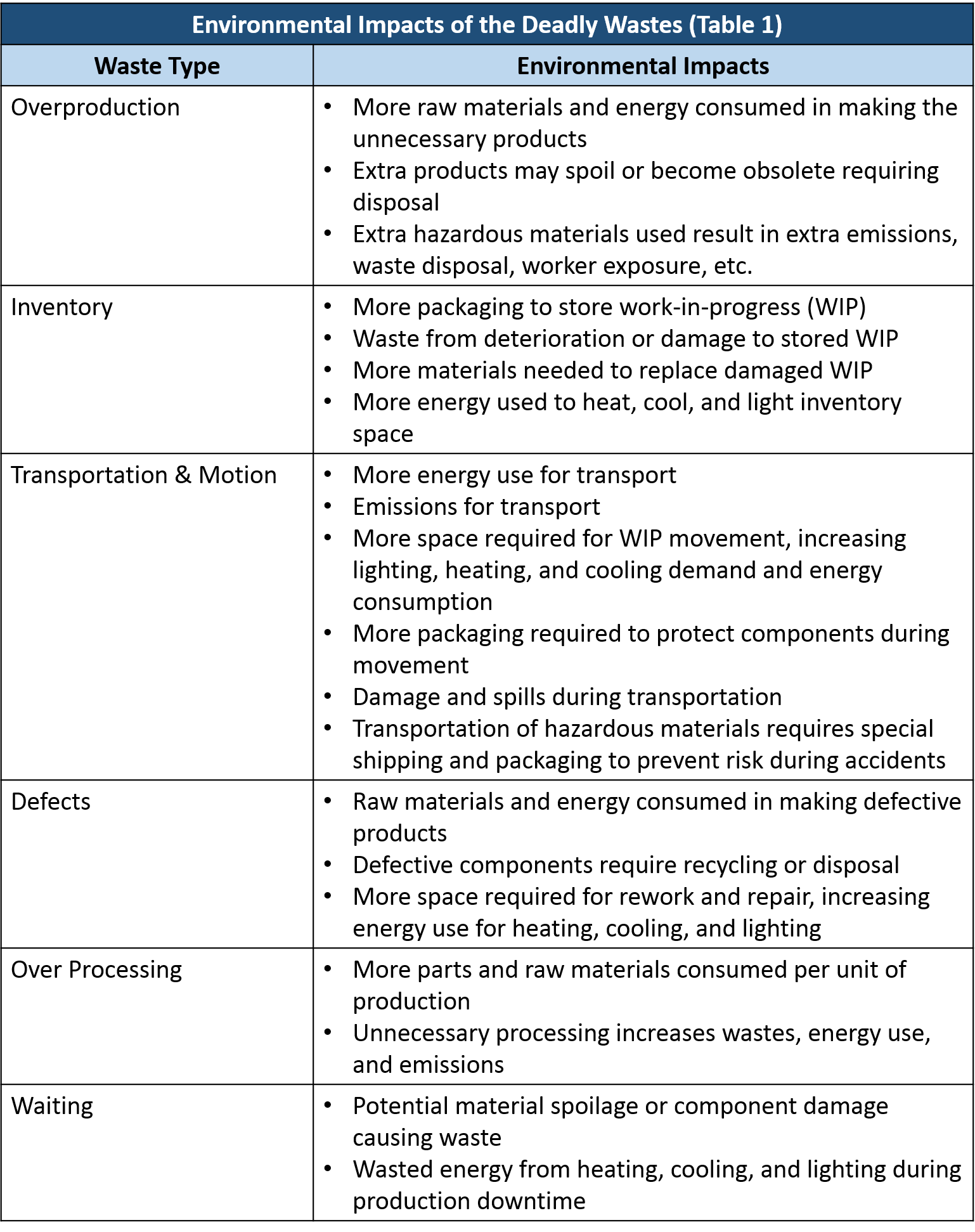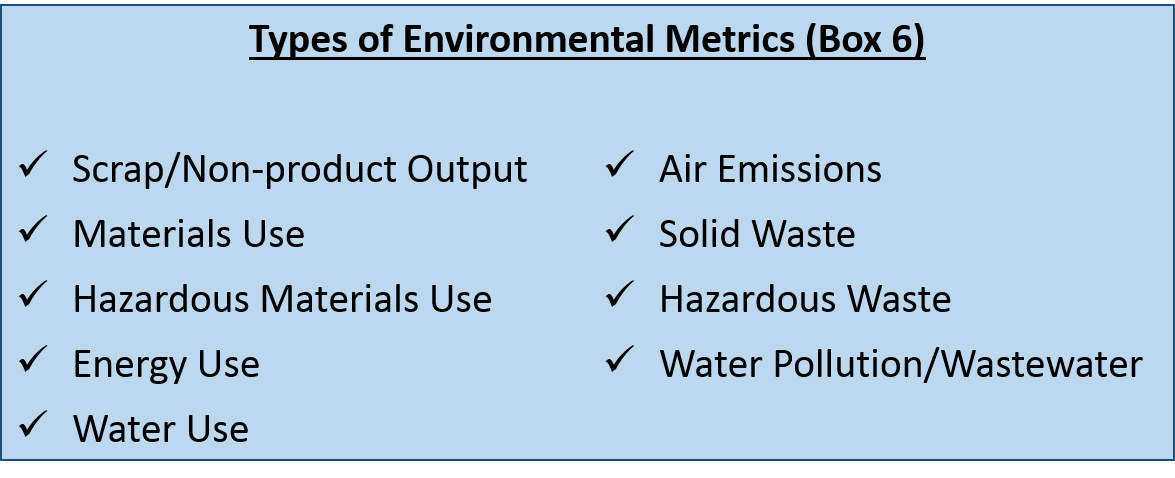Lean & Environment Toolkit: Chapter 2
Identifying Environmental Wastes
- Introduction to Identifying Environmental Wastes
- How to “Learn to See” Environmental Waste in Your Organization
- Conclusion
- Toolkit Navigation
Introduction to Identifying Environmental Wastes
This chapter defines environmental waste and describes strategies to encourage employees to identify and eliminate environmental waste as part of Lean efforts.
Definition of Environmental Waste

- Energy, water, or raw materials consumed in excess of what is needed to meet customer needs.
- Pollutants and material wastes released into the environment, such as air emissions, wastewater discharges, hazardous wastes, and solid wastes (trash or discarded scrap).
- Hazardous substances that adversely affect human health or the environment during their use in production or their presence in products.
Like other Lean wastes, environmental wastes do not add customer value. They also represent costs to the enterprise and society in general.
The Link Between Environmental Waste and Lean’s Seven Deadly Wastes
The focus of Lean is on eliminating any non-value added activity, or waste, from production. Lean typically targets seven so-called deadly wastes:
- Overproduction
- Inventory
- Transportation
- Motion
- Defects
- Over Processing
- Waiting


The table below lists environmental impacts that are associated with the deadly wastes targeted by Lean methods. By reducing these production wastes through Lean efforts, you can improve your organization’s environmental performance.

Despite these relationships between Lean “deadly wastes” and environmental wastes, Lean implementation efforts often overlook opportunities to prevent or reduce environmental wastes. Your company can enhance its Lean performance by ensuring that environmental wastes are explicitly identified during Lean events and activities. This can be done by extending Lean waste identification activities to consider wasted materials, pollution, and other non-product outputs.
This toolkit provides you with some tools to identify and eliminate environmental waste—including some that are well hidden—and to maximize the environmental gains from Lean implementation.
How to “Learn to See” Environmental Waste in Your Organization
Overview of Organizational Strategies
As Lean leaders know, people are the key to successful Lean implementation. In much the same way, organizational culture is an important aspect of effective integration of environmental, health, and safety objectives into Lean improvement efforts. While each organization has different needs, several organizational strategies will help to accomplish your company’s Lean and environment efforts.

2. Show management commitment and support.
3. Include environmental waste in Lean training efforts.
4. Make environmental wastes visible and simple to eliminate.
5. Recognize and reward success.
1. Add Environmental Metrics to Lean Metrics


Using environmental metrics in Lean efforts will allow your company to document the environmental benefits that are part of Lean implementation, as well as identify targets for future improvement efforts.
2. Show Management Commitment and Support
It is important that senior management—both facility management and EHS management—at your company show their support for improved Lean and environment performance. While it is possible to build management support from the bottom up through pilot projects, securing top-down management commitment helps to ensure the long-term success of Lean and environment efforts. Management can show support through the following types of activities:
- Invest in Lean and environment training.
- Provide resources, tools, and incentives to enable employees to succeed.
- Include Lean and environment concepts in speeches, newsletters, and other communications.
- Encourage Lean managers and EHS managers to collaborate.
- Set performance goals and objectives related to Lean and environment.
- Track Lean and environment progress and hold individuals accountable for meeting those objectives.
- Recognize and reward Lean and environment accomplishments.
3. Include Environmental Waste in Lean Training Efforts
One important way to help employees learn to see environmental waste is to integrate it into general Lean training programs. Here are a few suggestions:
- Your company might want to include a section on how to identify and eliminate environmental waste in introductory Lean training presentations.
- Consider modifying Lean’s seven deadly wastes to include an eighth waste—environmental waste—in training presentations and materials.
- Consider conducting a “waste walk” during Lean trainings where workers walk the shop floor and write down environmental wastes they observe.
- Develop checklists or a pocket guide with common environmental wastes to use during events and waste walks.
Two other types of Lean and environment training might be useful:
- Lean training for EHS personnel—to enable them to more effectively support Lean activities and help with identifying environmental waste; and
- Advanced environmental training—to enable employees to understand environmental and human health risks associated with materials selection and with product and process design.
Chapter 4 of this toolkit has suggestions for training Lean teams to recognize when process changes may cause potential harmful environmental impacts. In addition, the EPA is developing a series of Lean and Environment Toolkit Training Modules that could be a useful resource for designing training programs.
4. Make Environmental Wastes Visible and Simple to Eliminate
Your company can take advantage of Lean’s focus on visual controls to support your company’s Lean and environment efforts. Here are a few suggestions:
- Prominently display how individual production areas or departments are doing relative to targets for environmental metrics alongside Lean metrics.
- Incorporate environmental wastes into activity and production control boards, one-point lessons, and other signs about wastes on the shop floor.
- Apply 6S and mistake-proofing concepts to work areas where chemical use and management and waste collection and management activities occur. Use colors, signs, and other visual controls to reinforce proper chemical handling and waste management and environmental procedures.
5. Recognize and Reward Success

Your company may not always succeed with its Lean and environment efforts, so that makes it all the more important to recognize and reward successful efforts, to learn from any mistakes, and to continually try new things and work to improve your company’s performance.
Conclusion
Summary
Environmental waste is any unnecessary use of resources or substance released to the air, water, or land that could harm human health or the environment.
Environmental wastes, although not considered one of Lean’s seven deadly wastes, are embedded in or related to the wastes targeted by Lean methods. Like other Lean wastes, environmental wastes represent costs to your company. Making them an explicit target of Lean events can help your company to:
- Continually improve performance by expanding on the reduction of production wastes through Lean efforts;
- Identify and address areas of potential environmental benefits that might be overlooked by Lean alone; and
- Identity and eliminate hidden risks and wastes.
Using environmental performance metrics in Lean efforts enables managers to understand key areas for improvement. Types of environmental metrics include:
- Use of energy, materials, and water;
- Air emissions;
- Water pollution and wastewater; and
- Hazardous waste and non-hazardous solid wastes.
There are five organizational strategies that can help to integrate Lean and environmental waste reduction efforts.
- Add environmental metrics to the metrics considered in Lean efforts to better understand the environmental performance of production areas.
- Show management commitment and support for improved Lean and environmental performance by holding collaborative meetings and providing resources and recognition.
- Integrate environmental wastes into Lean training programs. This can be as simple as adding a few additional slides to a presentation or as advanced as holding a special Lean training for EHS personnel.
- Make environmental wastes visible and simple to eliminate by using signs and other visual controls in the workplace.
- Recognize and reward environmental success accomplished through Lean.
Your Thoughts
Now that you have finished this chapter, reflect on what you read by answering these questions:
- What did you learn in this chapter that was particularly useful?
- Do you need any more information to fully understand organizational strategies for eliminating environmental waste? Would any other tools be helpful?
Toolkit Navigation
- Contents & Acknowledgements
- Preface
- Chapter 1: Introduction: Getting Started with Lean & Environment
- Chapter 2: Identifying Environmental Waste
- Chapter 3: Value Stream Mapping
- Chapter 4: Kaizen Events
- Chapter 5: 6S (5S + Safety)
- Chapter 6: Conclusion and Implementation Strategies
- Appendix A: Lean Methods
- Appendix B: Basic Environmental Measures for Lean Enterprises
- Appendix C: Lean Event EHS Checklist
- Appendix D: Pollution Prevention Resources
- Appendix E: 6S Safety Audit Checklist
